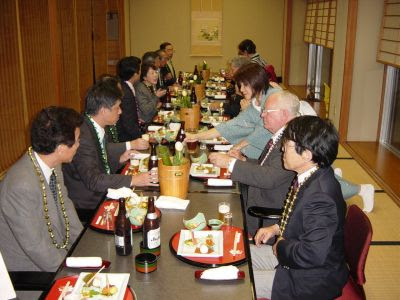
I just wish someone had told me.
My first business card was for a sister-city business development tour to Japan as a 16-year-old. It had the Y’s Men logo, my photo, name, and address complete with a nice glossy finish. I could hardly wait to pass them out. I felt so important and was sure the Japanese would be extremely impressed. Looking back years later, I am sure they were not impressed with me at all. But in keeping with the Japanese custom of polite behaviour, they never let on that I had insulted them. Had I known what follows, I would have made the effort to avoid coming off as the uncouth, disrespectful 16-year-old buffoon who stepped off the plane in Tokyo for the first time.
Here’s what I wish I had known, some big mistakes I could’ve avoided. Plus, a bonus Tip
Big Mistake #1- Lack of Respect
Before going to Japan, I had no idea of how important business cards were to them and in fact, to all Asians. As a cross-culturally naïve young North American, what I had thought were only bits of paper were documents to be treated with the utmost respect. Each card holds the information you need to start your business relationship on a positive note.
For instance, cards inform you about the person’s status, position, and sometimes the university they attended. It will show you how to address the person appropriately; Doctor Kim, instead of Mr. Kim, for example, or for a government official in Malaysia, the term “Datuk.” Business cards are essential to guide your future interactions in the most appropriate manner. Whether the person is the head of a multi-billion-dollar corporation or a cab driver, each expects and deserves your respect.
Big Mistake #2 – Not Handling with Care
Passing my cards out with one hand while in Japan was bad enough, but how I accepted and treated their cards in return was atrocious. One key contact was Dr. Namoto, a well-respected businessman in the local community. When introduced, I took his card with my one hand, just like we do in North America, and quickly stuffed it in my back pocket. Then I sat down. The look of horror on Dr. Namoto’s face still haunts me to this day.
Accepting Cards – the Right Way
Accept cards with both hands. Do not place your fingertips over the company logo or anywhere near the person’s name. Doing so is a sign of disrespect not only to the person, but to the organization as well. Instead, hold the card by its edges.
Giving Cards the Right Way
When giving your card, make sure your name is facing towards the person for easier reading. And, don’t have your fingers covering your company’s logo or your name. In Malaysia, you may need cards in multiple languages such as Malay, Chinese and English.
Big mistake #3 – Not Studying the Card
Take time to really study your contact’s card so that you can understand (the best you can) exactly who you are meeting. By doing this, you learn not just the person’s identity and title, but the degree of respect you need to show. Look for academic credentials. For instance, in Korea, graduating from a SKY university has great significance (SKY stands for Seoul University, Korea University, Yongsan University).
When I say study, I don’t mean spending an inordinately long time looking at it. Just look long enough to have a firm idea about who has given you their card.
Need more insights in how to do business in Asia?
Give us a call: 1 403 891 4630 or email info@focusasiamarketing.ca
Big Mistake #4 – Writing on the Card
Never, ever, write on the card—especially in front of your contact. This happens sometimes in North America but never in Asia. In Asia, writing on someone’s card not only defaces it but shows little to no respect for the person.
To help me remember things, I would make notes based on the card and the discussions I had, but only later in private. Taking the time to do this was worth its weight in gold. Not only did it make remembering details (such as who was who) easier but was a great resource for later. I am always impressed by how much Asians would remember about me and my company from only a brief discussion. Their secret? They were doing the same thing I was—making notes afterwards.
Big Mistake #5 – Disrespectful Placement
Where you place your contact’s card after studying it makes a big difference. Ideally, you would gently place it inside your card holder, that’s kept inside the left side pocket of your suit jacket. Why left and not right? Because it is closer to the heart; it demonstrates more warmth, sincerity, friendship, and respect. You can get away with carefully placing it inside your left-hand shirt pocket. However, never stuff it inside your front pants pocket or worse, like I did, in the back pocket. And, then sit down on it. No wonder Dr. Namato was horrified.
Big Mistake #6 – Jumbled Cards
At a business meeting or dinner, place the cards in front of you in the same seating order as your dinner guests. This is helpful, as it’s possible that many of those across from you will have the same last name. In Korea for instance, there are only 300 family names. Of these, almost 50% are named Kim, Lee, Choi (pronounced as Chay) or Park (pronounced as Pak). This can get confusing.
In formal meetings or negotiations, your Asian counterparts will enter and sit down according to rank. The highest-up person enters first, followed by others according to their rank. This is a good example of how in Confucius-based cultures, societies are structured in hierarchies whereby a person’s rank is clearly defined and must be maintained.
Big Mistake #7 – Dirty, crinkly cards
Because I had no clue how important cards are everywhere in Asia, I treated mine like pieces of scrap paper. As a result, it did not take long for my crisp and clean snazzy cards to look dirty and tired. What I had not noticed was that the cards I received always looked clean and fresh – no smudge marks or frayed corners. This was not only a sign of respect to me but also a sign of self-respect by the giver. Giving a battered card gives the impression that you really don’t care about them or yourself. Keep cards in a nice case to take with you. Extra cards can stay in their box not floating around free in your suitcase.
Bonus Tip – Spot the Boss
This one does not have to do with cards, but it’s an important nonetheless, specifically when dealing with large Chinese contingents. The person sitting across from you may be the head of the company, but they do not have the final say. They have power — to be sure — but the final approval always comes from the party official in attendance. It’s rare that you would be told exactly who that person is, as they prefer to blend into the background. It can be hard to guess who it is, but I would look for the quiet, unassuming person tagging along with the delegation. The one you might think is just a mid-level supervisor or manager? Nope. He or she holds the real power. Without their approval, things grind to a halt.
The moral of this little bonus tidbit is to treat everyone you meet with respect. You can never be 100% sure exactly who you are talking with, especially when it comes to the Chinese This is good advice when doing business in Asia (and anywhere else, for that matter).
If only I could time travel back and tell young Doug these things, he could have avoided a lot of embarrassment. We learn from our mistakes. The goof up’s I made as a teenage is now your gain. I wish you all the best on your journey entering Asian markets.
Need more insights in how to do business in Asia?
Give us a call: 1 403 891 4630 or email info@focusasiamarketing.ca
 Companies of all sizes are using video meetings at an ever-increasing rate. The benefits are well known. They’re convenient, no travel is required, and provide an instant real-time form of communication. Meetings with family, friends even colleagues are casual. There’s no need to” dress up” or being overly formal. This kind of relaxed, casual atmosphere may be welcomed here but not likely in Asia. When we conducting ourselves in video meetings with Asians, as we do here, we increase the chances of making costly mistakes. In addition, we don’t have the benefit of an in-person meeting. At least then we can try to make up for our mistakes. This is why being on our toes regarding the differences in business cultures is so important in video calls.
Companies of all sizes are using video meetings at an ever-increasing rate. The benefits are well known. They’re convenient, no travel is required, and provide an instant real-time form of communication. Meetings with family, friends even colleagues are casual. There’s no need to” dress up” or being overly formal. This kind of relaxed, casual atmosphere may be welcomed here but not likely in Asia. When we conducting ourselves in video meetings with Asians, as we do here, we increase the chances of making costly mistakes. In addition, we don’t have the benefit of an in-person meeting. At least then we can try to make up for our mistakes. This is why being on our toes regarding the differences in business cultures is so important in video calls.







